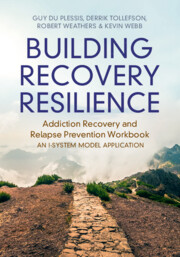 Building Recovery Resilience
Building Recovery Resilience Published online by Cambridge University Press: 28 May 2024
High-risk situations can be understood as events and situations that, if not effectively managed, pose a potential risk for relapse. What is important to note is that it is chiefly the individual’s subjective perception of “risk” that plays a significant role in whether a situation is high risk or not. A high-risk situation poses a threat to one’s perceived ability (what psychology calls “self-efficacy”) to handle the challenging situation at hand. Therefore, by developing more effective coping skills, thereby increasing perceived self-efficacy, one can learn to manage a high-risk situation without defaulting to substance use. This chapter provides practices that enables the reader to effectively deal with high-risk situations. The focus of this workbook is not to provide an exhaustive set of relapse prevention skills and tools but to help the reader to unlock their innate resilience through developing a Recovery Resilience Practice, so that they can effectively apply them.
To save this book to your Kindle, first ensure [email protected] is added to your Approved Personal Document E-mail List under your Personal Document Settings on the Manage Your Content and Devices page of your Amazon account. Then enter the ‘name’ part of your Kindle email address below. Find out more about saving to your Kindle.
Note you can select to save to either the @free.kindle.com or @kindle.com variations. ‘@free.kindle.com’ emails are free but can only be saved to your device when it is connected to wi-fi. ‘@kindle.com’ emails can be delivered even when you are not connected to wi-fi, but note that service fees apply.
Find out more about the Kindle Personal Document Service.
To save content items to your account, please confirm that you agree to abide by our usage policies. If this is the first time you use this feature, you will be asked to authorise Cambridge Core to connect with your account. Find out more about saving content to Dropbox.
To save content items to your account, please confirm that you agree to abide by our usage policies. If this is the first time you use this feature, you will be asked to authorise Cambridge Core to connect with your account. Find out more about saving content to Google Drive.